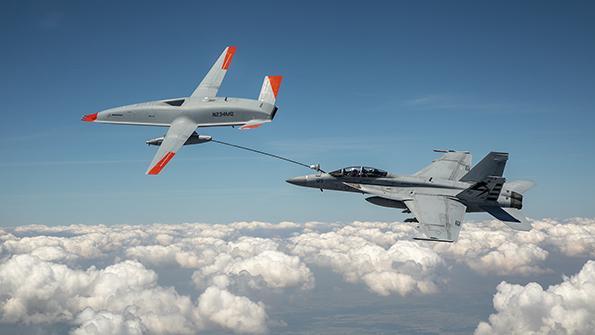Boeing Keeps Cash Goals, Cuts 737 Outlook While Defense Deficit Widens

MQ-25
Boeing’s dual challenges—commercial aircraft supply, and defense and space program execution—continued to haunt the aerospace and defense giant in the third quarter, leading to financial results that were slightly worse than expected. But the new red ink was not bad enough to undermine a key promise to shareholders.
Top Boeing executives on Oct. 25 reiterated their earlier promise to deliver at least $3 billion in free cash flow by year’s end, and $10 billion annually by 2026. The Arlington, Virginia, company has achieved just half of the 2023 goal through September, including a $310 million cash burn in the latest quarter. The cash flow goals are key targets that Boeing leaders have set for themselves and were expected to be maintained.
For investors, however, their reaffirmation was where the good news ended in Boeing’s third-quarter 2023 report. The company’s so-called core loss per share, a metric solely defined by Boeing, came in at $3.26, worse than Wall Street’s estimated loss of $3.18. Operating margins at the two largest divisions, commercial airplanes and defense & space, were negative 8.6% and almost negative 17%, respectively. The defense margin was twice as bad as executives forecast as recently as early September.
New charges on several defense and space programs (see table below) were to blame for the division’s worsening performance. As the company went to close the books on the quarter, executives acknowledged another $482 million hit must be recognized on the VC-25B Air Force One program, along with $136 million across several other programs that have been regular sources of charges, such as the MQ-25. But new this time, Boeing also recognized a $315 million hit to an unnamed satellite constellation program whose contract was signed years ago.
“These are disappointing results in the quarter and year to date,” Chief Financial Officer Brian West told analysts on a teleconference. “This performance is below our expectations, and we acknowledge that we aren’t as far along in this recovery as we expected to be at this stage.”
He asserted managers have a game plan for getting Boeing Defense, Space and Security (BDS) to high-single-digit margins by 2026, based on lean manufacturing, more rigorous program management and cost productivity.
Still, the swing in defense & space margins would be a roughly 25% change in no more than three years, and investors and analysts continue to be skeptical.
“We can think of reasons this may have happened on these individual programs, but the continued series of big charges remains a problem,” analysts at JPMorgan said. “This is not only because of the earnings hits; continued charges suggest management lacks understanding of costs in the business, since each charge is an upward revision to cost expectations versus only three months prior. And, we note that even after excluding charges, BDS still did not generate a real profit.”
At Boeing Commercial Airplanes, the financial results reflected news that Boeing has revealed in recent weeks. The most significant new announcement had to do with ratcheting down 737 expectations.
The scope of 737 aft pressure bulkhead (APB) rework and its related impact on delivery pace forced Boeing to lower its full-year projection to 375-400 deliveries, executives said on the call. The previous target of 400-450 was set late last year with an assumption that disruptions would occur, but the range was broad enough to be realistic even with a few unexpected hurdles, Boeing said.
The APB problems—improperly drilled holes by subcontractor Spirit AeroSystems—proved to be too large an obstacle to keep deliveries on track when their scope was expanded beyond the initial inspection areas discovered in August.
Adding more inspection areas forced Boeing to reinspect aircraft already checked for the first nonconformance, making delivery to customers more challenging.
After averaging about 33 deliveries per month through August, 737 customer handovers fell to 15 in September, putting Boeing at 286 through nine months. CFO West suggested October’s delivery total will be similar to September’s, which would leave Boeing with about 75 to deliver in the last two months to reach the bottom end of its revised full-year guidance.
“We know the scope,” West said. “We know what’s got to happen, and we’re working our way through finishing that work across that cohort of airplanes.”
The revised delivery expectations will not change long-term 737 production targets. Boeing anticipates reaching 38 aircraft per month by year’s end, slightly later than expected. But the goal of 50 per month before 2027 remains in place.
“We’ve had a master schedule out there for some time with the required rate breaks,” West said. “Of course, we’re trying to get our way to 50 per month by the [2025-2026] time frame. None of that has changed.”
Also unchanged are 787 ramp-up and delivery plans. Production is transitioning to five per month and remains on track to reach 10 per month around mid-decade. This year’s delivery totals will fall between 70 and 80, within the company’s latest expectations.
Boeing’s net loss was $1.6 billion in the latest quarter compared with a loss of $3.3 billion in the same 2022 period. Diluted loss per share was $2.70 versus $5.49. Revenue was $18.1 billion against less than $16 billion.
“Similar to the rest of the aerospace and defense industry, Boeing does not have an issue with demand—its issue is with supply, and also execution in defense,” analysts at Vertical Research Partners said. “We doubt if there will be a sudden hockey stick recovery from these issues, and that expectations for Boeing’s profitability and cash flow probably need to be tempered. And until these forecasts are grounded, we think that Boeing stock price could struggle to make consistent progress.”






